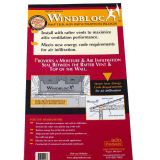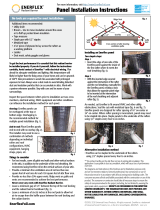Page is loading ...


Venmar sets the standard for the ventilation industry!
Venmar Ventilation inc. is North America’s most important manufacturer of residential air quality
equipment.
With over twenty-five years of innovation, Venmar Ventilation has been recognized as leader in the field
with its leading-edge technology and breakthrough ideas.
From basement to attic, kitchen to bathroom, Venmar’s wide range of high quality products has been
developed to meet your every ventilation need.
You have
ventilation
problems?
Venmar
has the solution!
Venmar attic ventilators give you the following advantages
Better corrosion resistance through the use of 24 and 26-gauge G90 galvanized steel and baked
enamel polyester paint;
Innovative design to prevent rain and snow infiltration;
Easy installation thanks to its multi-slope base;
Exclusive gutter to evacuate condensation and prevent roof material degradation;
Fine mesh grill (1/4” x 1/4”) to prevent blockage of the ventilator.

3
Table of contents
Table of contents
General information
Why install an attic ventilator? 4
How to evaluate an attic ventilator’s capacity? 4
National Building Code requirements 5
Number of ventilators needed for each roof configuration 6
Basic rules 8
Venmar attic ventilators 9
Recommendations for each type of installation
Soffits obstructed by insulation 11
Closed-in soffits 11
Warm or humid air source 12
Gable roof 12
Mansard roof 13
One-sided cathedral ceiling 13
Asymmetrical roof (without cathedral ceiling) 14
Cathedral ceiling with one slope 14
Installation steps
Attic ventilator components 15
Required tools and materials 15
Existing roof 16
New roof 17
Flat roof 18

Why install an attic ventilator?
4
Accumulation of ice on
the roof;
1
2
3
4
Frost in the attic;
Water infiltration that
can damage your
ceiling;
Accelerated degradation
of materials.
Moreover, the National Building Code requires adequate attic
ventilation.
According to both CSA standard
CAN-3-A93-M82 (National Building Code)
and the Home Ventilation Institute (HVI)
certification, the ventilation capacity of
attic ventilators in based on net ventilation
area. Refer to the table on page 9.
Installing an attic ventilator prevents :
How to evaluate an attic ventilator’s capacity?

2/12 slope or more =
1 ft
2
ventilation opening for 300 ft
2
of insulated ceiling surface (1/300).
5
National Building Code requirements
General information
1
Use square footage to determine required ventilation
2
Distribution of ventilation square footage
Slope less than 2/12 =
1 ft
2
ventilation opening for 150 ft
2
of insulated ceiling surface (1/150).
Exemple : A 40 ft x 30 ft house
(with a slope greater than 2/12)
A = 40 ft
B = 30 ft
A
B
40 ft x 30 ft = 1, 200 ft
2
÷ 300 =
4 ft
2
of ventilation
The National Building Code requires that 25 % of the 1/300
must be allocated to each of the upper and lower space of the
attic. When used in conjunction with the soffits, the attic
ventilator creates an updraft (chimney) effect to adequately
ventilate the attic.
25 %
25 %
For this example:
One sq.ft. (minimum) in the
upper part of the attic.
One sq.ft. (minimum) in the
lower part of the attic.
Refer to Section 9.19 of the
National Building Code for more
information.
(fig. 5.1)
(fig. 5.2)
(fig. 5.3)
(fig. 5.4)

Number of ventilators needed
for each roof configuration
6
1
Determine the attic surface area
2
Determine the number of ventilators required
In order to determine the attic surface area of an irregular shaped
house, divide the surface into several regular shapes.
A
B
C
D
A = 40 ft
B = 25 ft
C = 15 ft
D = 10 ft
To determine the total surface area, add up the surface of
each section:
(A x B) + (C x D) = total surface
(40 ft x 25 ft) + (15 pi x 10 ft)
(1, 000 ft
2
) + (150 ft
2
) = 1, 150 ft
2
Total attic surface = 1, 150 ft
2
.
25 %
25 %
Refer to section ventilated roof
area covered by ventilator in the
table found on page 9. This
shows the attic ventilator’s
capacity to ventilate the upper
space of the attic.
Be sure to ventilate the lower
part of the roof (with soffits
and/or air inlet). For more
details go to page 5 to see
the National Building Code
requirements.
(fig. 6.2)
(fig. 6.1)

7
For the example on the
previous page, model 60300
would be the best choice
because it is designed to
ventilate roof area from 700
to 1, 200 sq.ft.
It is important to choose a ventilator that is
rated for an area equal or lightly superior to
the actual attic surface area to be ventilated.
3
Distribute the ventilation square footage of the attic
One ventilator
Install the ventilator in the
middle of the roof.
More than one ventilator
Divide the roof into the number
of sections equal to the number
of ventilators required.
Then install the ventilators in
the middle of each section.
NOTE :
(fig. 7.1)
(fig. 7.2)
(fig. 7.3)
1/4
1/4
1/2
General information

Basic rules
8
We strongly recommend that
you close off the air inlets not
related to the attic ventilation.
The soffits must not be
obstructed and must meet the
National Building Code (see
page 5).
Make sure that there are no
sources of hot or humid air near
the different air inlets. If allowed
to enter, such heat or humidity
will create condensation in the
attic and cause material damage
to the roof (see page 11).
2
1
The roof must conform to the existing National Building Code
• It is very important that the attic insulation is
distributed evenly.
3
4
Error : too
close to
the soffit
(fig. 8.1)
(fig. 8.2)
(fig. 8.3)

9
Venmar attic ventilators
Venmar attic ventilators
Multi-slope base Existing base Flat roof base
60300 60100 60350 60310 60110
Opening(s) 31331
Net Ventilation 1 ft
2
0.60 ft
2
0.80 ft
2
1 ft
2
0.60 ft
2
Area (93, 000 mm
2
) (55, 800 mm
2
) (74, 400 mm
2
) (93, 000 mm
2
) (55, 800 mm
2
)
Ventilated roof area 700 to 1, 200 ft
2
0 to 700 ft
2
700 to 1, 200 ft
2
360 to 600 ft
2
0 to 360 ft
2
covered by ventilator*
Colors Black 60303 Black 60310 Black 60353 Black 60313 Black 60113
Gray 60305 Gray 60105 Gray 60355 Gray 60315 Gray 60115
Brown 60306 Brown 60106 Brown 60356 Brown 60316** Brown 60116**
Dimensions A 20” 20” 20” 20” 20”
B 18” 12 3/4” 14” 29 3/4” 24 1/2”
C 10” 4 3/4” 10” 10” 4 3/4”
D8”8”4”19 3/4” 19 3/4”
E 12 1/2” 12 1/2” - 18 1/8” 18 1/8”
F 20” 20” - 3 5/8” 3 5/8”
G 12 9/16” 12 9/16” 12 dia. 12 9/16” 12 9/16”
*Calculated for attics which have ventilated soffit around the whole house
**Special Order

Recommandations
for each type
of installation

If insulation obstructs the
house soffits, use an
attic deflector to move
the insulation aside.
If soffits are permanently
closed in, install air inlets.
Make sure that the number of
air inlets meets the National
Building Code (see page 5).
11
Closed-in soffits
Soffits obstructed by insulation
Recommendations for each type of installation
Attic
deflector
25 % upper
Air inlet
Obstructed
soffits
25 % lower
(fig. 11.1)
(fig. 11.2)

Warm or humid air source
Gable roof
If a warm air source is located
nearby an air inlet, you
should install an extra duct
fitted with a damper in order
to direct the air away from
the inlet.
Gables block air entry at the
soffits. It is therefore important
to follow the National Building
Code regarding lower-roof
ventilation (see page 5).
Error : too
close to
the soffit
25 % upper
25 % lower
12
(fig. 12.1)
(fig. 12.2)

The lower part of a mansard
roof does not need to be
ventilated. However, the
upper part must meet the
National Building Code (see
explanation on page 5).
Install one or more ventilators
on the “non-cathedral” side of
the roof. Close off 50 % of the
“non-cathedral” soffits and
leave the “cathedral” side
100% open.
13
One-sided cathedral ceiling
Mansard roof
Ouvert à 100%
50 %
closed off
100 %
open
(fig. 13.1)
(fig. 13.2)
25 % upper
Air inlets
Obstructed
soffits
25 % lower
Recommendations for each type of installation

Cathedral ceiling with one slope
Close off the soffit on the
highest side of the roof and
leave the soffit on the lower
side completely open. Because
of its small space, the air
inside the roof warms up
very quickly. It is therefore
necessary to double the
planned ventilation.
14
100 %
closed off
100 %
open
Double the planned ventilation
(fig. 14.2)
In this case, close off 50% of
the soffit located on the
shorter side of the roof and
leave the soffit on the longer
side completely open.
50 %
closed off
100 %
open
(fig. 14.1)
Asymmetrical roof (without cathedral ceiling)

15
Required tools and materials
Attic ventilator components
Installation steps
Gutter
Base
Upper section
Gutter
The following is required to install an attic ventilator :
Tape measure
Saw
Exacto-type knife
Drill
Tar
Caulking
Pencil
Spatula
Hammer
Level
Caulking gun
Water
drainage

Existing roof
16
1
Determine ventilator position
2
Create the roof opening
3
Prepare the base
4
Install the base
Distribute the ventilator(s)
evenly over the roof area.
Locate the opening so that
the inferior blade of attic
ventilator will extend above
the roof crest.
Remove only those shingles
nails located ABOVE and
BESIDE the opening.
Scribe a 12” x12” square on
the roof between the rafters
(check the position of the
rafters from inside the
house).
Cut the shingles and roofing
membrane inside the scribed
area and remove them.
Cut the opening in the roof.
Apply tar to the underside
and topside of the base
plate, except on the side
marked with an “A” (see
fig. 16.4, 16.5 and 16.6).
Make sure you do not
obstruct the ventilator
gutter hole (see fig. 16.5
and 16.6).
A
Carefully lift up the shingles
and slide the ventilator base
so that only the side marked
“A” is placed over the
shingles (see fig. 16.7).
Nail the flat part of the base
to the roof, except for the
side marked “A”, in order to
prevent water infiltration.
Then nail the shingles onto
the sides of the ventilator
(see fig. 16.6 and 16.7).
5
Install the upper section of
the ventilator
Slide the upper section on the base making sure that it is level.
Fit a screw on each side of the ventilator, except for the
uppermost side which is inaccessible (screws included).
Haut de la
toiture
To ensure water tightness, apply roof caulking to the edges
of the base (make sure not to obstruct the ventilator gutter).
Upper
roof
Lower
roof
(fig. 16.1)
(fig. 16.2)
(fig. 16.3)
(fig. 16.4)
(fig. 16.5)
(fig. 16.6)
(fig. 16.7)
(fig. 16.8)
1/4
1/4
1/2

17
New roof
1
Determine ventilator position
2
Create the roof opening
3
Prepare the base
4
Install the base
Place the opening so that
the inferior blade of the
attic ventilator will extend
above the roof crest.
Distribute the ventilators
evenly on the roof.
Scribe a 12” x12” square on
the roof between the rafters
(check the position of the
rafters from inside the
house).
Cut the opening in the roof.
Place the shingles up to the
lower edge of the hole.
Apply tar to the underside of
the base plate.
Make sure you do not
obstruct the ventilator gutter
hole (see Fig. 17.5).
A
Place the ventilator base
on the roof so that only
the side marked “A” is
placed on the shingles and
the other sides onto the
plywood of the roof (see
fig. 17.6).
Nail the flat part of the
base to the roof, except for
the side marked “A” (see
fig. 17.5 and 17.6).
Apply tar to the topside of
the base plate, except on
the side marked with an
“A” (see fig. 17.6).
Continue installing the
shingles around the
ventilator.
5
Install the ventilator’s upper section
Slide the upper section on the base
making sure that it is level (see fig.
17.8).
Fit a screw on each side of the
ventilator, except for the uppermost
side which is inaccessible (screws
included /see fig. 17.5 and 17.6).
To ensure water tightness, apply
roof caulking to the edges of the
ventilator base (make sure not to
obstruct the ventilator gutter).
(fig. 17.2)
(fig. 17.1)
(fig. 17.3)
(fig. 17.4)
(fig. 17.5)
(fig. 17.6)
(fig. 17.7)
(fig. 17.8)
Haut de la
toiture
Upper
roof
Lower
roof
1/4
1/4
1/2
Installation steps

Flat roof
18
1
Prepare the roof area
On the roof cut a 12’’ x 12’’ opening.
(fig. 18.1)
2
Install the wood base*
Install the wood base* over the hole.
Nail the wood base* to the roof .
(fig. 18.2)
3
Install the upper section of the ventilator
Install and nail the ventilator base on the wood
base*.
Install the upper section on the ventilator base
making sure that it is level. Make sure that this
one exceeds the edges of the roof.
Fit a screw on each side of the ventilator.
(fig. 18.4)
(fig. 18.3)
Apply the tar on the wood base*.
Apply the roofing membrane on the roof
until inside the wood base*.
Important: make sure you include air intake(s) on your roof.
Fit a
screw on
each side
(fig. 18.5)
* Not included

Five-year Warranty
The Venmar Attic Ventilator is made of high-quality 24 and 26-gauge G90 galvanized
steel covered with baked enamel polyester paint.
Venmar is proud to offer you a five-year corrosion warranty. During this period, Venmar
Ventilation inc. will replace the product in-store upon original proof of purchase.
IMPORTANT
It is the roofer’s responsibility to ensure that the base of the ventilator is « completely »
watertight by using the appropriate roofing products. The Quebec Association of
Master roofers (AMCQ) recommends the following method:
Metal Flashing :
The flashing must first be coated with a sealer. Then immerse the coated flashing in
plastic roofing cement bed and install it on the roof. Brush on hot asphalt then cover
with a layer of 15-pond asphalt felt paper. Re-apply hot roofing asphalt and attach a
sheet of tar paper or a layer of fibreglass cloth. Cover literally with a final coat of hot
roofing asphalt.

Certification
Technical data was obtained using CSA’s CAN3-A93-M82 Standard and
its published results carried out by CRIQ (an industrial research center).
For further information, comments, or suggestions, please contact us at
Venmar Ventilation inc.
550, Lemire Blvd
Drummondville (Quebec) J2C 7W9
Tel: 819 477-6226 – Toll-free: 1 800 567-3855
Internet : www.venmar.ca
91077 02/05
/







